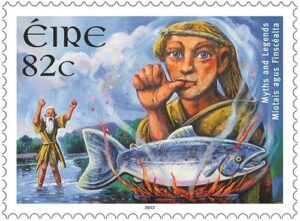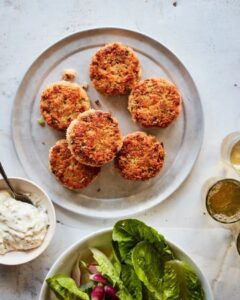
Celtic mythology is ripe with wonderful stories with one particularly about the Salmon of Knowledge and Finn McCool, the leader of the great warrior band, the Fianna. In the story Finn was a young lad and went to live with his tutor, the wise Fineagas near the River Boyne in Ireland. There was rumored to be ‘The Salmon of Knowledge’ in the river and Fineagas was always trying to catch it to make himself even wiser, for it was said that the first one to taste the salmon would be given sight into the future and into the past, thus making him the wisest man in Ireland. But the salmon always escaped Fineagas. Then one day he was fishing and saw the beautiful fish swimming near where he was teaching Finn. Finneagas grabbed his net and threw into the water, ultimately catching the salmon. He told Finn to cook the salmon but under strict orders not to taste it. Near the end of the cooking a hot bit of oil from the salmon splattered onto Finn’s thumb. It was painful so he automatically stuck his thumb into his mouth to ease that pain, thus tasting the salmon of knowledge and acquiring all the knowledge of the world. Finneagas was upset at first because he wanted the knowledge but soon realized it was better suited for a young man with more years ahead of him. With the knowledge from the Salmon of Knowledge, Finn MacCool grew up to be the leader of the legendary Fianna warriors with many wonderful adventures.
Real Atlantic salmon (Salmo salar) are found in the temperate and arctic regions of the northern hemisphere which includes Scotland. Atlantic salmon live in freshwater as juveniles but migrate to sea as adults before returning up-river to spawn and then return to their native river, and often to the same stretch of the river from which they were born.
Medieval regulation of salmon fishing in Scotland has its roots in statutes made by King David I (c. 1084-1153). He originally gave fishing rights to monks and then began to hand them out to noblemen, sold them for money, and gave them for service to the Crown. The earliest Act of the Scottish parliament pertaining to fishing, unrepealed by subsequent legislation, was passed in 1424.
This legislation, having to do with rivers and riverbanks, ensured that rivers were open to all, particularly for navigation. Originally this also applied to fishing in these waters. At some point in the 12th century a distinction was made between “whitefish” (all fish from a river) and fish of the salmon kind. This began the long history of laws governing who, where, how, andwhen people could fish for salmon.
The person who owned the fishing rights also had the right to cross the property near the river. These fishing rights were hereditary and, at first, only pertained to net fishing. By the middle of the 19th century, rod fishing had become economically valuable and rules pertaining to that style were added.
Conservation was not an issue in those early days. Even though there were laws limiting the times you could fish there was not originally a limit on the number of fish you could catch.
When conservation of salmon became necessary, there were two measure passed. The first was to limit how fish are caught. The original legislation was designed to prohibit any commercial method which would be too efficient. This eliminated any fixed device set up in the river. The only legal form of netting was “net & coble,” where a seine net of modest efficiency was “shot” in a semi-circle from the riverbank and the two ends were brought together to trap the fish.
The second measure was to invoke closed times when fishing was prohibited: roughly from October through January, the main spawning time. During the fishing season there is an additional closure called the “Saturday slap,” originally the 24 hours from midnight Saturday to midnight Sunday but subsequently lengthened in duration. This was to allow an escapement during the fishing season. Salmon escapement is when the fish elude commercial and recreational fishing to go on to reproduce.
These laws were rarely enforced, and the first two penalties were light. The third penalty was death, also rarely enforced. Conservation was not a strong consideration during the Victorian era. The supply of fish seemed unlimited. But, by the middle of the 1800’s some fisheries became aware that the number of salmon was declining.
Years of conflict among fisheries ensued. Laws were passed and often ignored. Rod fisherman were in conflict with the net fishermen. Different methods of fishing were invented and subsequently banned but the number of commercial fisheries increased, and the supply of salmon continued to decrease.
Although many methods of restocking the river were attempted it wasn’t until the early 1970’s that the Scots discovered how to raise Atlantic salmon to maturity in farms. This resulted in the thriving salmon industry of today. While there is controversy over fish farms impact on the environment, and whether farm salmon are as flavorful as wild salmon, the industry has made salmon available to everyone.

Salmon Fritters
Ingredients:
- ½ pound (about 2 cups) of cold, boiled, boned, salmon
- 2 heaped tablespoons flour
- 2 eggs beaten
- ¼ pint (1/2 cup) milk or cream
- Salt and cayenne pepper
- Oil for frying
For the sauce:
- 4 0z. (1/2 half cup) melted butter
- 2 tablespoons cream
- 2 teaspoons flour
- 2 teaspoon soy sauce
- 2 teaspoons mushroom ketchup (perhaps HP sauce or Worcestershire Sauce could be substituted)
Instructions
Flake the salmon, add the flour, the beaten eggs, and enough milk or cream to make the mixture a soft dough. Season to taste. Have the oil very hot, and drop in tablespoons of the mixture. Fry until golden brown on both sides, then drain on paper. Keep warm.
To make the sauce, mix the cream with the flour and add to the melted butter. Heat it, stirring all the time. When it has thickened slightly add the soy sauce and the mushroom ketchup. Mix well. Serve over the fritters.
These fritters can be made with almost any whitefish or shellfish such as lobster or crab.
Serves 3 to 4.
Sources:
- Iain A. Robertson – Salmon Conservation in Scotland – A History of Legislative Tradition and Private Action
- A Taste of Scotland, Theordora Fitzgibbon, Houghton Mifflin Company, Boston 1971. P.109
- Tradition Arts-Culture Scotland

